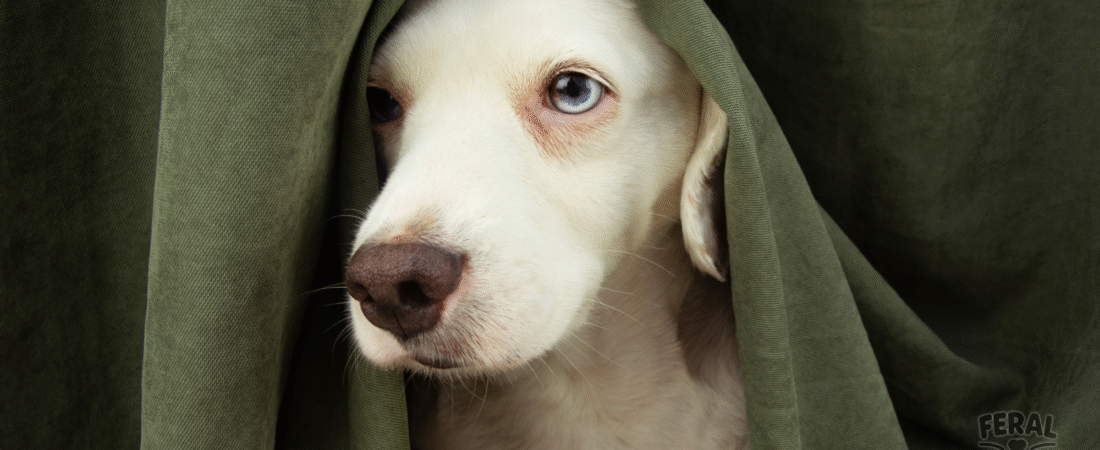Why Separation Anxiety Matters

Separation anxiety is one of the most common behavior issues in dogs and also one of the most misunderstood. Owners might describe their dogs as “naughty” when they chew, bark incessantly, or soil the house while left alone. In reality, these are signs of a dog experiencing panic and distress when separated from their human.
This issue is not only difficult for owners (frustration, damaged property, noise complaints) but is also very stressful for the dog, lowering their wellbeing and, in severe cases, risking their safety.
Understanding what separation anxiety is—and is not—is the first step toward helping your dog feel secure even when you’re away.
What Separation Anxiety Is (and Isn’t)
- What it is: A panic disorder in dogs caused by being left alone or separated from their people. It is a mental health condition, not disobedience.
- What it isn’t: It’s not “bad behavior,” stubbornness, or revenge. Your dog is not trying to punish you—they are scared.
1. Causes of Separation Anxiety
Several factors can contribute:
- Change in environment: Moving to a new home, change in schedule (e.g., going back to the office after remote work).
- Change in household: Loss of a family member, new baby, new pet.
- Shelter history: Many rescue dogs develop anxiety due to previous abandonment.
- Over-dependence: Dogs that follow their owners everywhere may never learn independence.
- Lack of early training: Puppies not gradually desensitized to alone time are more vulnerable.
2. Common Signs of Separation Anxiety
- Vocalization: Excessive barking, whining, or howling once the owner leaves.
- Destructive behavior: Chewing doors, windows, furniture, or digging at exits.
- Elimination indoors: Urinating or defecating only when left alone (not due to lack of potty training).
- Pacing/restlessness: Repetitive movements, inability to settle.
- Drooling/panting/excessive salivation during alone time.
- Escape attempts: Trying to break through doors, jump fences—dangerous and can cause injury.
- Shadowing: Following owners from room to room, panicking if separated by even a door.
3. How Vets & Trainers Diagnose It
- Behavior history: Examining patterns (only happens when alone, not when humans are home).
- Video monitoring: Many owners record their dogs when away to confirm signs.
- Rule out medical issues: Incontinence, pain, or illness must be excluded by a vet before concluding anxiety.
4. How to Help Dogs with Separation Anxiety
Step 1: Rule Out Medical Problems
Take your dog to the vet. A urinary tract infection or gastrointestinal distress might mimic “anxiety accidents.”
Step 2: Build Independence Gradually
- Desensitization: Start by leaving for only seconds, gradually increasing the time.
- Counterconditioning: Pair departures with high-value rewards (food puzzles, stuffed Kongs).
- Stay calm on departures/returns: Overly emotional greetings and goodbyes increase anxiety.
Step 3: Use Tools to Reduce Stress
- Safe space: Crate (only if trained positively) or a gated room with toys.
- Soothing cues: Calming music, TV/radio background noise.
- Scent comfort: Leave worn clothing with your smell.
Step 4: Mental and Physical Stimulation
- Daily walks & exercise: Tired dogs are less anxious.
- Puzzle feeding: Keeps mind engaged when alone.
- Training games: Builds confidence and problem-solving.
Step 5: Professional Intervention
- Certified trainers/behaviorists: Can create tailored desensitization plans.
- Medication (last resort with vet prescription): For severe cases, SSRIs or anti-anxiety meds may help during training.
5. Do’s and Don’ts
✔ Do build independence gradually.
✔ Do reward calm behavior when leaving.
✔ Do provide daily structure, training and exercise.
✔ Do use enrichment toys and calm environments.
✘ Don’t scold your dog for destructive behavior or accidents—it increases anxiety.
✘ Don’t “flood” your dog (leave them alone for long periods hoping they “get used to it”). This worsens panic.
✘ Don’t over-comfort before leaving—it highlights your departure.
6. Holistic and Budget-Friendly Supports
- Natural calming aids: Chamomile, L-theanine, or CBD oil supplements (vet guidance needed).
- Thundershirts & pressure wraps: Provide calming comfort for some dogs.
- Homemade enrichment: Frozen Kongs, cardboard box shredding, DIY treat puzzles.
- Routine consistency: Dogs thrive on predictable meal, walk, and rest times.
7. FAQs
Q1: Will getting another dog solve separation anxiety?
Not usually. These dogs panic over separation from people, not necessarily loneliness.
Q2: My dog destroys furniture but only when I’m gone—is that separation anxiety?
Yes, especially if destruction is focused near doors/windows.
Q3: Can I crate my dog during alone time?
Yes, if crate-trained positively. For anxious dogs without training, crates may worsen panic.
Q4: Should I ignore my dog before leaving?
Stay neutral—brief, calm departures work better than drawn-out goodbyes.
Q5: How long will training take?
It varies. Some dogs improve in weeks with consistent training, others require months.
Final Takeaway
Separation anxiety is not misbehavior—it’s a form of panic disorder. With patience, structured alone-time training, and a calm environment, most dogs can learn to feel safe when their humans are away. For severe cases, professional help and medical support make an enormous difference.
By recognizing the signs early, avoiding punishment, and supporting your dog with both structure and compassion, you’ll transform time alone from terrifying into tolerable—and eventually normal.

